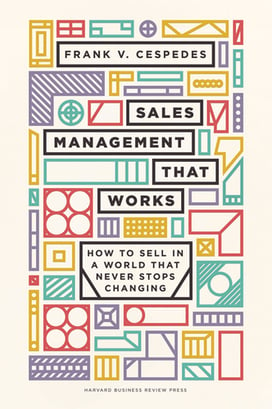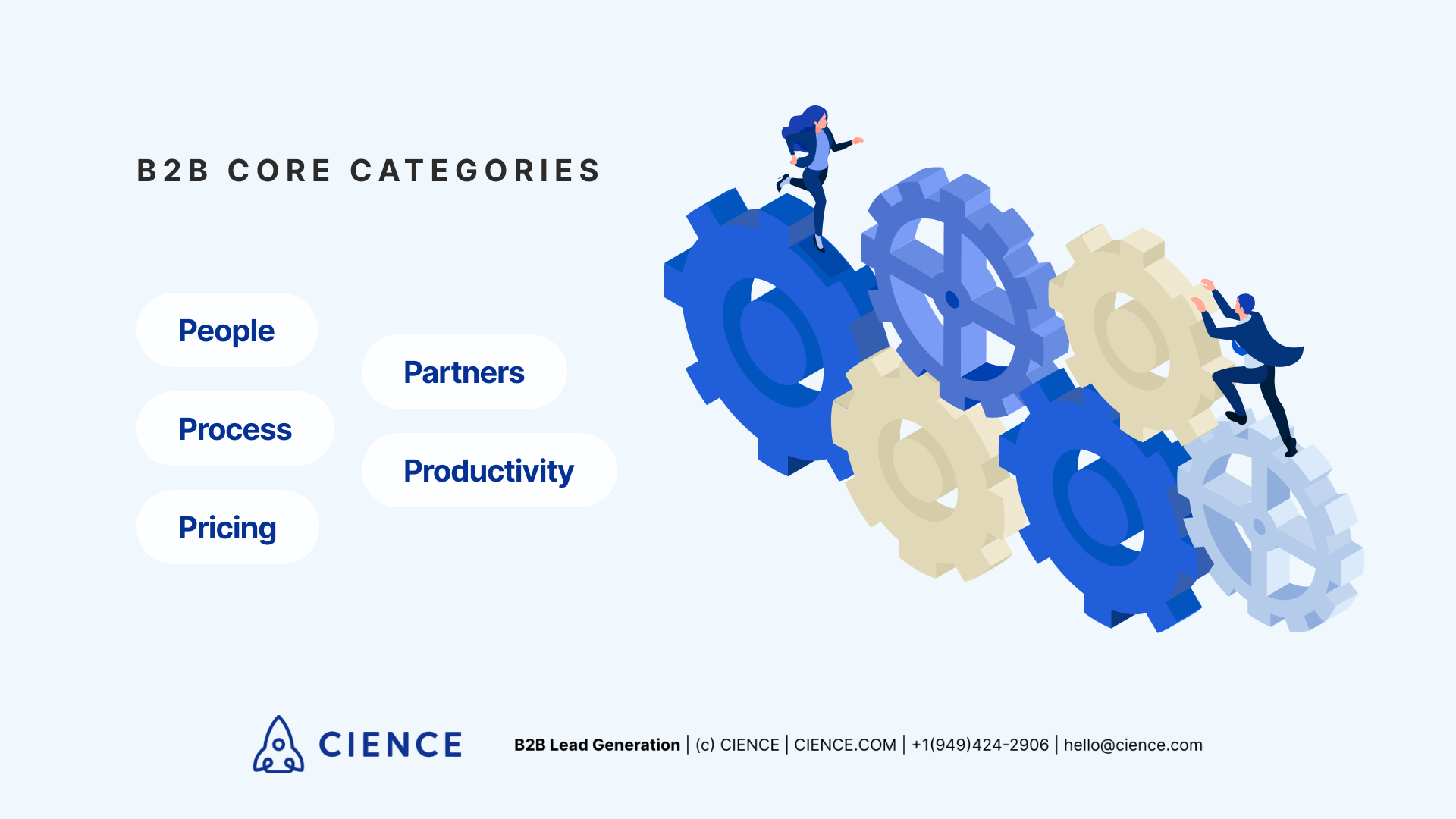Harvard Business School professor and sales expert Frank Cespedes gets straight to the point in a recent Q&A with CIENCE about his newly released book, Sales Management That Works: How to Sell in a World That Never Stops Changing (Harvard Business Review Press, 2021): Throughout his career, as senior lecturer at Harvard Business School with eleven years experience running a B2B business, he states that he has been surprised and dismayed by the relatively low level of rigorous attention paid to sales processes in many companies.
 Cespedes, who has focused much of his academic research on B2B go-to-market elements, including channels and sales management, indicates that while selling is changing, the impact on sales of e-commerce, big data, AI, and other megatrends is often misunderstood: “When managers fail to separate fact from hype, they make decisions based on bad assumptions and, in any competitive market, fall victim to those who can understand cause-and-effect links between buying and selling,” says Cespedes.
Cespedes, who has focused much of his academic research on B2B go-to-market elements, including channels and sales management, indicates that while selling is changing, the impact on sales of e-commerce, big data, AI, and other megatrends is often misunderstood: “When managers fail to separate fact from hype, they make decisions based on bad assumptions and, in any competitive market, fall victim to those who can understand cause-and-effect links between buying and selling,” says Cespedes.
So how can B2B companies and business leaders better understand the links between buying and selling to avoid common sales mistakes? Cespedes discusses the challenges with CIENCE in this three-part blog series—with powerful insights into how to do business in a new buying reality.
The New B2B Sales Reality
Q: What Motivated You to Write Sales Management That Works?
A: Of all the core business functions, sales is the most context-dependent. Selling software is different than selling capital goods, professional services, or durables, and selling multi-year licensed software is different than SaaS. Selling in the U.S. differs from selling in Asia, Europe, Latin America, the Middle East, and so on. Yet, of the business functions, sales is the area where pundits, bloggers, and others feel most comfortable making context-free generalizations, usually supported by no or N=1 data. So, for professional reasons, I want to discuss what research does and doesn’t tell us about selling in different contexts.
Because selling is changing it’s also a good time to clarify the cause and effect links between buying and selling because the pandemic has raised the stakes of getting this right or wrong. Daily, we read predictions about “new normals,” but most are simplistic straight-line extrapolations of contagion and semi-lockdown conditions.
The fact is that, in its economic impact, the coronavirus has not been an equal-opportunity plague. Some sectors have been much more impacted than others. But across B2B sectors, it has stressed cash, forced cap-ex reviews and priorities, often changed who buys and why, and extends selling cycles. In recovering from the crisis, it’s more important than ever to separate the signals from noise.
Q: Can you give a brief overview of what your new sales book will discuss?
A: The most important thing about selling is buying: who buys, why, and how. For over a half-century, buying has typically been framed in terms of a hierarchy-of-effects model: moving a prospect from Awareness to Interest to Desire to Action. The AIDA formula and its many variants are the basis (often, the unconscious basis) for sales activities in most firms. It assumes a linear, sequential process, and most CRM systems are based on this assumption, providing inside-out data about a company’s sales funnel and the “pipeline” metrics that dominate talk about sales in books and blogs.
But research indicates a different buying reality. Rather than moving sequentially through a funnel, buyers now engage in parallel activity streams to make a decision; they’re online and offline throughout buying journeys, getting and evaluating information from multiple sources beyond salespeople. In many B2B markets, for instance, sites like PowerReviews, Marketo’s Marketing Nation, the SAP Developer Network, and others provide customers’ unedited opinions and usage experiences with a product, and both product and price comparisons now typically take just a few clicks for buyers in most markets.
This does not mean disintermediation or the death of the salesperson. In fact, the number of sales people in the U.S. has steadily increased throughout the twenty-first century even as the internet grew in scope and access. But it does affect sales tasks and core areas of sales management, including hiring, training, incentive plans, pricing, channel management, and what it means to construct and reconstruct a sales model relevant to buying as it works today, not yesterday.
B2B Sales People and Processes

Q: Your book outlines the impacts in core categories: people, process, pricing, partners, and productivity. How do these fit together to drive B2B sales forward? Where do teams start?
A: The categories overlap, and that’s the point. Effective selling is ultimately an organizational outcome where people and performance management practices fit the sales process, pricing approach, and choices about go-to-market partners. Andrew Carnegie was once asked, “Which element is most important for the success of a business: brains, capital, or labor?” His reply: “Which leg of a three-legged stool is most important?” The fit of People, Process, Pricing, and Partners drives sales Productivity.
How you do that will depend on your particular business context. But my advice is to start with people. In the aggregate, hiring in sales is often more expensive than most cap-ex decisions in companies, and firms already spend 20% more per capita on sales training than they do in other functions. Yet most current hiring practices exacerbate the difficulties, and the ROI from sales training is disappointing. The book examines aspects of sales talent that should inform hiring practices, how to get better, and actionable links between hiring and training.
Q: So let’s start with people: What should companies understand about sales hiring and how to improve their hiring practices?
A: Sales hiring presents some unique challenges that are important to recognize. Unlike many other business functions, there is no easily identified resource pool or educational priors for sales positions. If you’re looking for an engineer, you can go to an engineering school and find people who have studied electrical engineering, chemical engineering, and so on.
 For an accountant, finance person or software developer, you can find majors in those subjects. But few colleges and universities have sales programs or even a sales course. Meanwhile, more than 50% of U.S. college graduates, regardless of their majors, will work in sales at some point in their careers. And remember: Whatever you call them, business development is what many associates, partners, and vice presidents do daily. Most salespeople therefore start with little preparation and must learn-by-doing on the job. In dealing with these hiring challenges, avoid a few common mistakes:
For an accountant, finance person or software developer, you can find majors in those subjects. But few colleges and universities have sales programs or even a sales course. Meanwhile, more than 50% of U.S. college graduates, regardless of their majors, will work in sales at some point in their careers. And remember: Whatever you call them, business development is what many associates, partners, and vice presidents do daily. Most salespeople therefore start with little preparation and must learn-by-doing on the job. In dealing with these hiring challenges, avoid a few common mistakes:
Decades of research show that managers over-rate their ability to predict someone’s performance and fit for job tasks on the basis of interviews.
Correlations between interview ratings and job success vary from about .1 to .4—less than the .5 rate of flipping a coin. Some studies, especially in service jobs like sales, show a negative correlation between interview assessments and job performance: the firm would have been better off selecting at random!
Selling is about behaviors, so always get multiple perspectives on a candidate and, whenever possible, supplement interviews with internship-type hiring scenarios, task assignments, job trials, and other activities where you can judge the person’s behaviors, not their interview self.
Previous experience is the most common criterion in sales hiring, but that can be misleading. But “experience” in sales can refer to any (or any combination of) the following:
- a customer group (for example, a banker or broker hired by a software firm to call on financial-services prospects);
- a technology (an engineer or field-service technician hired to sell the equipment);
- a company (in many B2B firms, service reps move to sales because internal coordination is a key sales task and they “know the people and how to get things done here”);
- a geographical market or culture (for instance, someone from that country or ethnic group who knows the norms of the customer’s culture);
- or selling (an inside-sales rep who has demonstrated she can successfully work in that transaction-intensive sales model).
The relevance of each type varies with your firm’s sales tasks. Require the people doing the hiring to clarify what they mean when they use “experience” as a key criterion.
Because sales tasks are determined by buying contexts, what you do and don’t need in a sales hire differs greatly by industry. Hire for the task, not the title. But many companies do precisely the opposite. Degree inflation (the difference between the demand for a college degree in job postings and the educational background of employees actually performing those tasks) is a growing phenomenon, and sales occupations are the biggest category affected by degree inflation.
Sometimes requiring more education is justified: Many sales jobs do have more data-analysis requirements. But too often, it is unnecessary and hurts both companies and society. Many employers have simply defaulted to using college degrees as a blunt proxy for a candidate’s skills. Especially in sales, where on-the-job learning is a big driver of development, you should embrace a more expansive view of talent, with less weighting given to degrees and more to the tasks involved. Every sales job has implicit required behaviors. Take the time to clarify and make that explicit in your job postings and hiring pool.
What’s Up Next
In our next discussion with Frank, we’ll talk to him more about his new book, how to comprehend the cause and effects of buying and selling, and ways to build coherent sales strategies that align with B2B business goals.
Frank Cespedes
Faculty Chair of the Aligning Strategy and Sales program at Harvard Business School
Frank Cespedes teaches at Harvard Business School and is the author of six books including Aligning Strategy and Sales (Harvard Business Review Press, 2014) which was cited as “the best sales book of the year” (Strategy & Business), “a must-read” (Gartner), and “perhaps the best sales book ever” (Forbes). His newest book is Sales Management That Works: How to Sell in a World That Never Stops Changing (Harvard Business Press, 2021).

